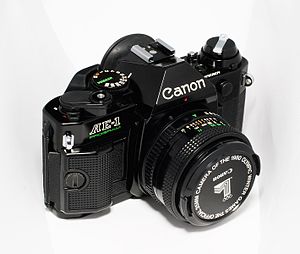This article needs additional citations for verification. (February 2022) |
The Canon AE-1 Program is a 35 mm single-lens reflex camera that uses Canon's FD mount lenses. It was introduced in April 1981 as the successor to the Canon AE-1, five years after that camera's introduction.[1] The major difference was the addition of the Program AE mode first seen in the A-1. This mode sets both the shutter speed and aperture automatically—albeit with a slight bias towards the shutter speed setting. The user focuses the camera and then presses the shutter button. For those desiring more control, the AE-1's shutter priority auto-exposure and full manual modes are still available.
 Canon AE-1 Program with all-black finish | |
| Overview | |
|---|---|
| Maker | Canon Camera K. K. |
| Type | 35 mm SLR |
| Released | 1981 |
| Production | 1981-? |
| Intro price | ¥60,000 (equivalent to ¥77,852 in 2019), body only[1] |
| Lens | |
| Lens mount | Canon FD |
| Sensor/medium | |
| Film speed | ISO 12 to 3200 [manual] |
| Recording medium | 135 film |
| Focusing | |
| Focus | Manual |
| Exposure/metering | |
| Exposure | Program, shutter priority, manual |
| Exposure metering | EV1 to EV18 @ ASA 100 |
| Flash | |
| Flash | Hot shoe |
| Flash synchronization | 1/60 s |
| Shutter | |
| Shutter speed range | 2 s to 1/1000 s |
| General | |
| Battery | 4LR44 6V battery or 4 LR44 1.5 volt batteries |
| Dimensions | 87 × 141 × 47.5 mm |
| Weight | 575 g |
| Made in | Japan |
Features
editLike the A-1, the AE-1 Program has a right-hand "action grip" on the front of the camera. It also supports the A-1's Motor Drive MA; this requires another electrical contact on the base plate. The AE-1's Power Winder A, and a new, faster Power Winder A2, are also supported. The viewfinder uses LEDs to show information to the user.
Also like the A-1, the AE-1 Program supports interchangeable focusing screens. Unlike the A-1, though, which specifies that screens should only be changed by the factory or by experienced service technicians, those on the AE-1 Program can be changed by the user. The camera came standard with the new split/microprism screen, but seven others were available. The focusing screen on the AE-1 Program is brighter than any previous focusing screen on any Canon manual focus camera, allowing the user to focus with greater ease with "slow" lenses (up to f/5.6). It is the same focusing screen design that is used in the newest model of the top-of-the-line Canon F-1 (known as the New F-1).
The AE-1 Program retains the older A-series type electromagnet-controlled cloth-curtain shutter that limits top shutter speed to 1/1000 of a second, together with a rather slow flash sync speed of 1/60 second. In the years since the AE-1 Program was introduced, this shutter design has also proven to be more maintenance-intensive than modern vertical-travel metal blade designs. The camera's electronics and electromagnets are powered by one 4SR44, PX28A, A544, K28A, V34PX, 4LR44, or L544 alkaline battery.
The additional electronics used for the program features of the AE-1P have resulted in more electronic gremlins over the years, and the model is considered by some[by whom?] more difficult to repair than earlier and simpler A-series cameras. In its day, however, the AE-1 Program's automated features and simple controls helped introduce many new consumers to the SLR camera.
Gallery
edit-
Canon AE-1 Program body with silver finish
-
Canon AE-1 Program with telephoto lens and power winder
-
AE-1 Program with Canon 50mm 1:1.8
See also
editExternal links
editReferences
edit- ^ a b "AE-1 Program". Canon Camera Museum. Retrieved August 14, 2021.